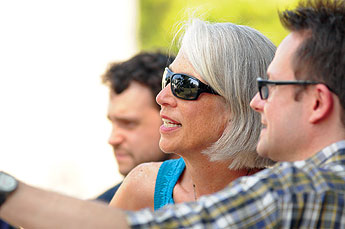Burnishing the Brightest Stars
Continued, next two pages
Too much talent is going to waste and it seemed like a very urgent, opportune moment for me to jump in and help. CTY’s mission is more important now than ever before. ”— Elaine Tuttle Hansen, CTY executive director
“Apparently most of the activities here at CTY involve fruit,” Hansen jokes as she surveys the hubbub of the afternoon’s outdoor activities.
Observing classes earlier that day, Hansen is just as curious and engaged. In an Introduction to the Biomedical Sciences class where students are running tests to determine the cause of a fatal case of food poisoning, she circulates through the room asking the seventh- and eighth-graders about their findings. And during a Fast-Paced High School Physics lab, she watches intently as clusters of students work on a complex problem involving the speed and accuracy of an arrow shot from the top of a building. “Now was that easy or hard?” she asks a student whose group is among the first to solve the problem.
“When I thought about it logically, it seemed pretty simple,” she’s told.
His response makes her smile. “Everything we know about learning tells us you learn best in a community and that certainly seems to be true here,” she says later. “The fact that you can create that sense of community in only three weeks is pretty extraordinary.”
If Hansen seems at home on a college campus surrounded by high-achieving students, that’s because she is. For the past nine years, she served as the president of Bates College, guiding the prestigious liberal arts school through a period of major growth. Before that, she was a professor of English and provost of Haverford College. Now after more than 30 years as an educator and academic leader in higher education, she’s turned her attention to gifted education for K-12 students because she feels a sense of urgency about the need for what she calls “visible champions” for academically advanced youth.
CTY quickly responded to a clear gap in so many students’ regular education systems. For so many … CTY was a saving grace.”— William Durden, CTY executive director, 1980–1996
“Just like a highly selective liberal arts college, CTY represents a great idea that works well, but it is in some sense endangered by challenges and needs to be presented, promoted, made visible, and celebrated,” she says. “The future of academic promise is at risk given what we know about the budget cuts to gifted education programs in schools and the tremendous focus nationally in the last decade on No Child Left Behind. Too much talent is going to waste and it seemed like a very urgent, opportune moment for me to jump in and help. CTY’s mission is more important now than ever before.”
Today CTY is a global leader in gifted education, a robust program that has educated nearly 500,000 students from 120 countries. Its beginnings were decidedly more modest. “The early years were very rudimentary—we were finding our own way,” says William G. Durden, who became the Center’s first executive director in 1982. “There was no other program like us—it was all unexplored territory. And that’s what made it so exciting.”
During his 16 years as executive director, Durden helped expand courses beyond mathematics to include science and the humanities, added Summer Programs sites, established the protocols for the long-term financial success of the organization, and put in place the mechanisms for Talent Search and academic program stability. He also guided the organization as its researchers began to examine the implications that the CTY model of learning—which blended diagnostic testing, enrichment and acceleration—had for education. “CTY quickly responded to a clear gap in so many students’ regular education systems,” says Durden, now the president of Dickinson College. “We clearly tapped into a bleeding need, and we were able to organize ourselves rather quickly to respond to that. For so many students, CTY was a saving grace.”
Lea Ybarra, who became CTY’s executive director in 1997, took what Durden had established and expanded the Center’s racial, geographic, and economic diversity. “What we’ve done is open up CTY to many people in this country and internationally who weren’t served before,” says Ybarra, who left CTY this July after 14 years of service. As the Center became more financially secure, she worked to make it more accessible to bright students from families of limited financial means. “There’s no doubt CTY is a much more diverse group than we were before, and that’s made it a much, much richer place.”

Hansen and Galen White, assistant director of Summer Programs. The Summer Programs, which started with 109 students in 1980, welcomed 9,233 students in 2011.
Elaine Tuttle Hansen, Executive Director, CTY
- President, Bates College, 2002–2011
- Provost, Haverford College, 1995–2002
- Professor of English, Haverford College, 1980–2002
- Assistant Professor of English, Hamilton College, 1978–1980
- Author, Reading Wisdom in Old English Poetry (University of Toronto Press, 1988); Chaucer and the Fictions of Gender (University of California Press, 1992); and Mother Without Child: Contemporary Fiction and the Crisis of Motherhood (University of California Press, 1997)
- Ph.D. University of Washington, M.A. University of Minnesota, A.B. Mount Holyoke College
- Board Member, Carnegie Foundation for the Advancement of Teaching
